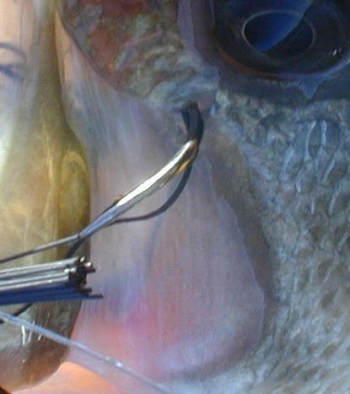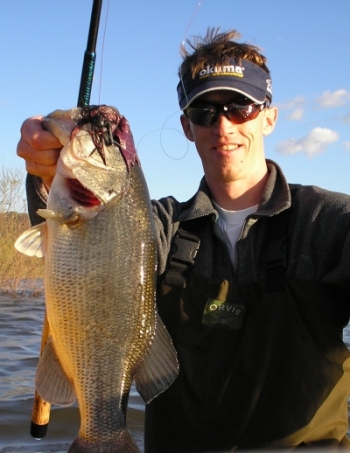|
A jig is one lure but it has components. Picking the "right" jig for a given day means picking the right components.
The hook is what connects you to the fish after you have him hooked. This sounds dumb but it's important. I used to fish almost entirely with wide gap hooks. I also used to lose a lot of fish that got off shortly after the hookset, especially bigger fish it seemed like. I now have all of my wide gap hook jigs in a bag in the bottom of my plastic worm bucket and I'll sell them to you for cheap. I only use jigs with standard hooks. I believe the standard hooks are key when a fish has entirely inhaled your jig to the back of it's mouth. If you set hard with a standard hook, the hook will penetrate the roof of the mouth. With a wide gap hook, the hook has much less bite and often times it doesn't stick in the roof of the mouth. The fish opens it's mouth and about 2 seconds after you

thought you had a fish on, it's gone. Take a look at the picture below of a 5 pounder I caught, and you will see what I mean. A hookset through the bony part of the mouth like this would be very hard to achieve with a wide gap hook. As far as what brand of hook, I would recommend two, maybe three brands. I fish Assalt jigs which use Mustad Ultrapoint hooks. A very sharp hook, but also a very sturdy hook that doesn't bend easily at the tip. The Gamakatsku hook is an excellent hook and is extremely sharp, but it will get bent and dulled at the tip quite easily around rip rap and wood. Owner hooks are decent as well, I just don't like the cutting point very much because I feel like it tends to open a bigger hole in the fish's lip, which might help it to get away.
There are a lot of theories out there on the weedguard. Some guys trim it just above the tip of the hook. Other guys thin threads out where the weedguard is glued into the jig. Other guys spread the weedguard out by bending it to the sides. When you buy a jig you need to think of the weedguard as raw material to be crafted to your needs. I prescribe to the school that cuts some threads out of the weedguard at the base. I also like to fan the bristles out around the hook. I have had terrible luck cutting the weedguard shorter above the hook. This just makes it stiffer which is not a good thing. To test my jigs I like to tap my pointer finger on the weedguard towards the hook. If I feel the hook point with a sharp tap of the finger I figure that's good. If I feel 3 or 4 bristles instead of the hook, that's bad. If your finger comes back bloody you are tapping too hard!
When you think about what jig head to use, let the cover dictate your choice. With a little trial and error you will quickly realize that a football head is terrible in weeds, but a bullet head is great. You'll also find that bullet heads tend to get stuck in rocks quite a bit but football heads don't. If you are fishing cover where you want a slow falling presentation, such as shallow water, you might want an arkie tpye head to slow the fall of your bait. Along those same lines it's worth mentioning that as a rule you should use the lightest head you can get away with when you are fishing rocky areas. This keeps your jig from falling in the cracks between the rocks. The only exception would be if you are fishing fast with a 1 or 1.5oz football head but that's a whole different ballgame. I don't believe that fish bite the jig because they see the shape of the head. They bite it because it was presented to them correctly. Water temperature also dictates how heavy of a lead head I use. If it's very cold water in the 40's I'll use a light head like a 1/4oz to get a softer, slower action. If it's warm and the fish are agressive, I'll use a heavier head looking for more of a reaction type bite as the jig moves rapidly by the fish.
I can't make any real definitive comments on rattles. I always use them if it's really murky but in clearer water I often go sans rattle. I don't like jigs that have the rattle molded to the underside of the hook, but if you are only fishing pork trailers I guess that's an ok setup.
The trailer is what makes the jig! There are probably 100+ things you can use as a jig trailer but let's skip to what I know works.
Probably my favorite trailer is a full size brush hog. I know this isn't the first thing that jumps to mind when you think of jig trailers, but then again I've never been accused of doing things the normal way when it comes to fishing. I take a brush hog and cut it right between the two little wings (about ¾" back from the head). I thread it on the hook so that the hook comes out right between the base of the wings. This trailer is very bulky and slows the fall of your jig really well. It also gives a great illusion of a crawdad and has good action at slow speeds with the two thin tentacles. Most importantly, the brush hog wings cause the trailer end of the jig to float up off of the bottom assuming the posture of a ticked off crawdad. You have to see this in a tank to understand it. It just looks killer and the fish think so too. This stand up posture is KEY to jig fishing.
 Getting back to the normal thing, my second favorite trailer is a 5" twin tail grub. I use this mostly in open water and in deep water. It also seems to get bit better in warm water when the fish are more active. When you look at this trailer in the tank you will notice something interesting. The legs of the grub after you stop it will often unfold slowly outwards. It's subtle but I think it's the kind of thing that triggers strikes. Give a twin tail jig a little pop and then kill it. It falls to the bottom and the legs unfurl themselves. Kind of like a crawdad that touched down on the bottom, noticed a threatening bass near by and decided to stick up its claws. This trailer doesn't float up off the bottom that well but it does catch a lot of fish. Getting back to the normal thing, my second favorite trailer is a 5" twin tail grub. I use this mostly in open water and in deep water. It also seems to get bit better in warm water when the fish are more active. When you look at this trailer in the tank you will notice something interesting. The legs of the grub after you stop it will often unfold slowly outwards. It's subtle but I think it's the kind of thing that triggers strikes. Give a twin tail jig a little pop and then kill it. It falls to the bottom and the legs unfurl themselves. Kind of like a crawdad that touched down on the bottom, noticed a threatening bass near by and decided to stick up its claws. This trailer doesn't float up off the bottom that well but it does catch a lot of fish.
In the pork arena I have only found one pork that I really like. It's Super Pork and it's the 3" x 1" pork. This pork has awesome stand up features. It postures just like a defensive crawdad, and when you stop the jig the pork arms waft lazily back and forth before coming slowly to rest on the bottom. Other porks that I have tried so far just don't do this and I really need to find a bigger pork than the 3 x 1 for winter time fishing. Any tips, send them my way.
Other notable trailers include 5" and 6" single tail grubs, and 4" twin tail grubs. I personally have not had much success with the "chunk" trailers like the Zoom chunk, but I know that a lot of top sticks use them.
It certainly pays to experiment with jig trailers. While I may be a brush hog guy, you might find out that you do really well on Zoom chunks. Fish at different lakes key on different things so cycle through the box a bit and see what gets the best response for you.
| 